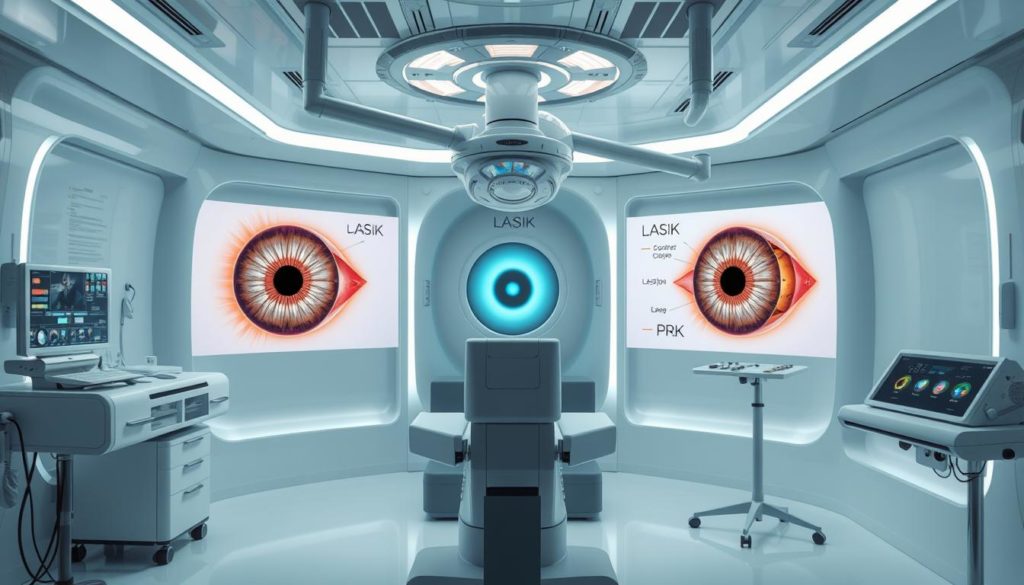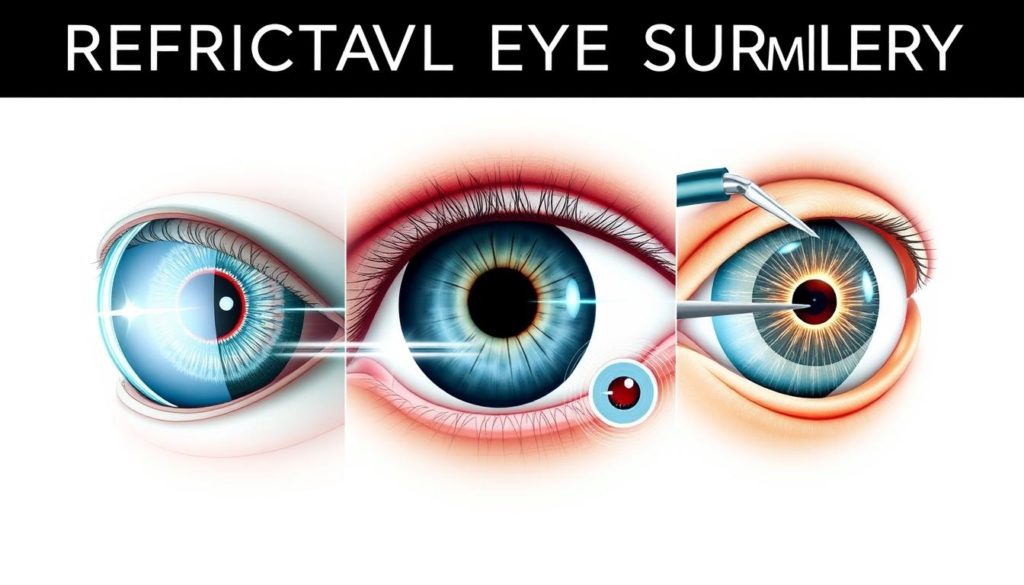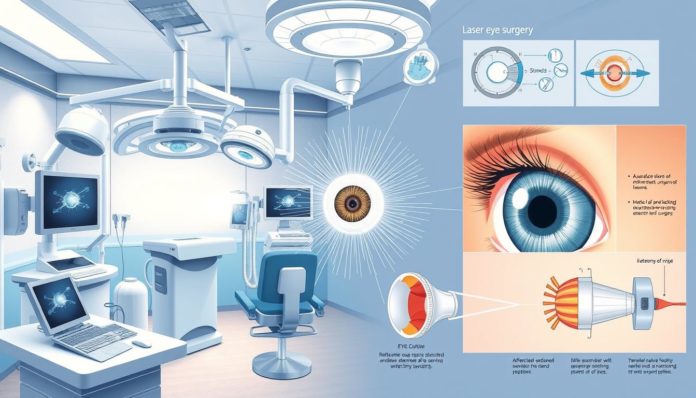Did you know over 10 million Americans have had LASIK since 1999? This shows how popular vision correction surgery has become. It also shows how technology has made these surgeries better and more available.
Welcome to our guide on refractive and laser eye surgery. We’ll explore LASIK, PRK, and SMILE. These surgeries are now safer and work better, thanks to new technology. They’re a good choice for those tired of glasses or contacts.
Knowing about different eye surgeries helps pick the right one for you. We’ll cover what happens before, during, and after. We’ll also talk about the benefits of clear vision. Let’s start our journey to better eyesight!
Introduction to Refractive and Laser Eye Surgery
Refractive and laser eye surgery have changed the way we treat vision problems. These surgeries have come a long way, thanks to LASIK surgery and PRK surgery. They are top choices for many looking to improve their vision.
Refractive surgery changes the eye’s shape to fix vision issues. It’s a big leap from ancient methods to today’s laser technology. LASIK surgery and PRK surgery are key examples, reshaping the cornea for better vision.

Learning about these surgeries shows how far we’ve come in vision correction. From simple tools to advanced lasers, these refractive surgery options offer lasting solutions. They help with common issues like nearsightedness, farsightedness, and astigmatism.
This guide will cover the various refractive surgeries and what to expect. Join us as we explore the world of vision correction. We’ll start with the basics of LASIK surgery and PRK surgery.
Types of Refractive Eye Surgery
Refractive surgery options have grown over time. They now offer different ways to fix vision problems. We’ll look at LASIK, PRK, and SMILE Surgery.
LASIK Surgery
LASIK is a top choice for vision correction. It makes a thin flap on the cornea. Then, the flap is lifted to reshape the cornea with an excimer laser.
This method is known for quick healing and high success rates. It’s best for those with mild to moderate vision issues.

PRK Surgery
PRK, or Photorefractive Keratectomy, is another good option. It doesn’t create a flap like LASIK. Instead, it removes the outer cornea layer for reshaping.
It’s recommended for those with thin corneas or can’t have LASIK. While recovery is longer, it offers similar results.
SMILE Surgery
SMILE Surgery, or Small Incision Lenticule Extraction, is a newer choice. It makes a small incision in the cornea. Then, a small piece of tissue is removed to reshape the cornea.
SMILE is known for its precision and quick recovery. It’s a great option for those wanting fast results with little downtime.
| Feature | LASIK Surgery | PRK Surgery | SMILE Surgery |
|---|---|---|---|
| Corneal Flap | Yes | No | No |
| Recovery Time | Short | Longer | Short |
| Ideal Candidates | Mild to Moderate Myopia, Hyperopia, Astigmatism | Thin Corneas, Not Suitable for LASIK | Most Patients Seeking Minimal Downtime |
Preparing for Laser Eye Surgery
Starting your journey to better vision requires careful preparation. The first step is the initial consultation. Then, you must follow certain pre-surgery guidelines. Let’s explore these steps to make sure you’re ready for this important surgery.
Initial Consultation
The initial consultation is a detailed meeting with your eye surgeon. They will check if you’re a good candidate for laser eye surgery. You’ll undergo several tests and exams, including:
- Measuring corneal thickness
- Mapping the corneal surface
- Assessing your eyeglass prescription
- Evaluating overall eye health
These tests help find the best surgery for you. It’s also a chance to ask questions and clear up any doubts.
Pre-Surgery Guidelines
After being cleared for surgery, it’s important to follow certain guidelines. Here’s a checklist to help you get ready:
- Stop Wearing Contact Lenses: Wear glasses for at least two weeks before surgery. This lets your corneas return to their natural shape.
- Avoid Makeup and Lotions: Don’t use makeup, creams, or lotions near your eyes a few days before surgery. This prevents contamination.
- Arrange Transportation: Make sure someone can drive you home after surgery. You won’t be able to drive right away.
- Follow Fasting Instructions: Your surgeon might tell you not to eat or drink a few hours before surgery.
Being proactive in preparing for laser eye surgery can make the process smoother. By following the initial consultation and pre-surgery guidelines, you’re setting yourself up for a successful surgery. This is a big step towards improving your vision.
Guide to Refractive and Laser Eye Surgery
Exploring refractive and laser eye surgery can be tough, but knowing the basics helps. These surgeries fix common vision issues like nearsightedness and farsightedness.
The main aim of vision correction surgery is to lessen the need for glasses or contacts. Thanks to new tech, LASIK, PRK, and SMILE are now options. Each has its own benefits and fits different needs.
- Technological Advances: New methods in refractive and laser eye surgery have made treatments safer and better.
- Patient Candidacy: Not everyone can have these surgeries. A skilled eye doctor must check if you’re a good candidate for vision correction surgery.
- Personalized Approach: Treatments are tailored to fit each person’s vision needs. This makes results better and patients happier.
Personalization is crucial in vision correction surgery. Every person’s eyes are different, so treatments must be made just for them. Using advanced tools helps doctors plan precise surgeries.
Learning more about refractive and laser eye surgery helps people make smart choices about their vision. Knowing about new tech, who can get surgery, and the need for custom treatments shows how valuable these surgeries are.
LASIK Surgery: What to Expect
Thinking about LASIK surgery? This guide will walk you through what happens before, during, and after. You’ll learn about the surgery, its benefits, and the recovery process.
Procedure Overview
The LASIK journey begins with a detailed eye check-up. This includes measuring your eye’s shape and thickness. Then, a laser reshapes your cornea to improve your vision. The whole thing usually takes under 30 minutes.
Benefits of LASIK
LASIK offers many advantages:
- Improved Vision: Most people see 20/20 or better after surgery.
- Quick Results: You might notice big improvements in just 24 hours.
- Reduced Dependence on Glasses: LASIK can make you less reliant on glasses or contacts.
LASIK Recovery
Recovering from LASIK is usually quick and not too painful. Here’s what you can expect:
- Immediate Post-Op: You might feel some discomfort and see blurry at first. But it gets better in a few hours.
- First Few Days: Use eye drops as directed to prevent infection and dryness. Stay away from hard activities.
- Long-Term Care: Go to all your follow-up appointments. This helps your eyes heal right and keeps your vision in check. Most people are fully recovered in a few weeks.
PRK Surgery Explained
Photorefractive Keratectomy (PRK) is a laser eye surgery that reshapes the cornea to correct vision. It’s different from LASIK because it doesn’t create a corneal flap. This makes it a good option for some people.
How PRK Differs from LASIK
PRK surgery and LASIK start differently. LASIK makes a thin flap in the cornea. PRK removes the top layer of the cornea instead. This choice can be important for people with thin corneas or those who might get eye injuries.
Here’s a quick comparison:
| Aspect | PRK | LASIK |
|---|---|---|
| Corneal Flap | No | Yes |
| Initial Healing Time | Longer | Shorter |
| Suitability for Thin Corneas | Better | Moderate |
PRK Surgery Procedure
The PRK surgery process includes several steps:
- Applying anesthetic eye drops to numb the eye
- Removing the corneal epithelium
- Using an excimer laser to reshape the cornea
- Placing a protective contact lens to aid in healing
The whole procedure takes about 15 minutes per eye.
Recovery and Results
The recovery after laser eye surgery like PRK takes longer than LASIK. Patients might feel some discomfort for a few days. It can take weeks to months for full healing and clear vision. But, the results of PRK surgery are similar to LASIK, offering great vision correction.
- Initial recovery: 1-3 days of discomfort
- Visual stability: 1-3 months
- Follow-up appointments: Regular check-ups to monitor progress
Vision Correction Surgery Options
There are many vision correction surgery options beyond LASIK and PRK. We aim to explore different techniques, compare them, and find the best fit for you.
Different Techniques and Procedures
It’s important to know about the refractive surgery options available. Here are some key methods explained:
- LASIK (Laser-Assisted in Situ Keratomileusis): A top choice, it reshapes the cornea for better vision.
- PRK (Photorefractive Keratectomy): Good for those with thinner corneas, it removes the surface before reshaping.
- SMILE (Small Incision Lenticule Extraction): A less invasive option, great for those with dry eyes.
- RLE (Refractive Lens Exchange): Ideal for over 40s, it replaces the natural lens with an artificial one.
- ICL (Implantable Collamer Lenses): A reversible choice, where a lens is placed between the iris and natural lens.
Determining the Best Option for You
Finding the right procedure requires a thorough evaluation of several factors:
- Eye Health: Detailed exams check cornea thickness, pupil size, and overall eye health.
- Lifestyle: Your daily activities and profession can influence your choice.
- Vision Goals: Whether you want to be completely free from glasses or just reduce dependency, your goals are important.
| Procedure | Ideal Candidates | Advantages |
|---|---|---|
| LASIK | Most adults with stable vision | Quick recovery, minimal discomfort |
| PRK | Individuals with thin corneas | Suitable for active lifestyles |
| SMILE | Patients with higher degrees of myopia | Less invasive, fewer dry eye symptoms |
| RLE | People aged 40 and above | Addresses presbyopia |
| ICL | Younger adults with moderate to severe myopia | Reversible, no corneal reshaping |
Talking to a qualified surgeon about these vision correction surgery options can help you choose the best procedure for your needs and goals.
Choosing a Laser Eye Surgeon
Finding the right laser eye surgeon is key when you’re looking into laser eye surgery. Making a smart choice can greatly affect your surgery’s success and your experience. Here’s what to look for and ask during your consultation.
What to Look for in a Surgeon
First, check the surgeon’s experience and focus. Look for those with many successful surgeries under their belt. Also, make sure they specialize in the surgery you want, like LASIK, PRK, or SMILE.
Questions to Ask During Consultation
Ask important questions during your consultation to gauge the surgeon’s skill and your comfort. Some questions to consider are:
- How many years have you been performing laser eye surgeries?
- What is your success rate with the procedure?
- Can you provide references from past patients?
- What are the potential risks and complications?
Checking Credentials and Reviews
It’s crucial to verify the surgeon’s credentials and read reviews. Ensure they are board-certified and part of respected groups, like the American Academy of Ophthalmology. Online reviews and testimonials can also give you a glimpse into the surgeon’s reputation and patient experiences.
| Criteria | Importance | Details |
|---|---|---|
| Experience | High | Number of surgeries performed |
| Specialization | Medium | Expertise in specific procedures |
| Credentials | High | Board certification and affiliations |
| Patient Reviews | Medium | Feedback from previous patients |
Choosing the best laser eye surgery requires thorough research and careful thought. These steps ensure a successful and fulfilling visual correction journey.
Risks and Benefits of Laser Eye Surgery
Thinking about laser eye surgery to fix your vision? It’s key to look at the risks and benefits. Every surgery has risks, and laser eye surgery is no exception. But knowing these can help you decide if it’s right for you.
Common Risks and Complications
Laser eye surgery is mostly safe, but some risks exist. These include dry eyes, glare, halos, and vision not being perfectly corrected. Rarely, infections or healing problems can happen. It’s important to know these risks before starting your journey.
Long-term Benefits
But, many see big benefits from laser eye surgery. Imagine waking up with clear vision, no glasses or contacts needed. This makes life easier and gives stable vision for years. Most people can get back to normal quickly after surgery.
Thinking about both risks and benefits helps you decide if laser eye surgery fits your goals and lifestyle.
FAQ
What is refractive and laser eye surgery?
Refractive and laser eye surgery fix vision problems like nearsightedness and astigmatism. These surgeries, like LASIK and PRK, change the cornea. This helps light focus better on the retina, improving vision.
What are the main types of refractive eye surgery?
Main types include LASIK, PRK, and SMILE. Each has its own method and benefits. The right one depends on your eyes and needs.
How do I prepare for laser eye surgery?
First, you’ll have a consultation with your eye doctor. They’ll check if you’re a good candidate. Then, follow their pre-surgery advice, like not wearing contacts or taking certain meds.
What should I expect during LASIK surgery?
LASIK makes a small flap on the cornea. Then, a laser reshapes the tissue underneath. The surgery is quick, and vision often improves right away. Recovery is short.
How is PRK surgery different from LASIK?
PRK doesn’t make a flap. It removes the outer cornea layer and reshapes the tissue with a laser. It’s for those with thinner corneas or other LASIK issues.
What are the risks and complications associated with laser eye surgery?
Risks include dry eyes and glare. Halos and over/undercorrection are also possible. Talk to your surgeon about these risks and the chance of needing more surgery.
How do I choose the best laser eye surgeon?
Look for experience and a good track record. Ask about their credentials and success rates. Read reviews and make sure you’re comfortable with your surgeon.
What are the long-term benefits of laser eye surgery?
Benefits include better vision and less need for glasses or contacts. Many enjoy clear vision for years, improving their life quality.
What is the recovery process like after laser eye surgery?
Recovery varies by surgery. LASIK patients can usually return to normal quickly. PRK takes longer. Follow your surgeon’s post-op care to heal well.
Are there other vision correction surgery options besides LASIK and PRK?
Yes, options include SMILE, LASEK, and lens implants like ICL. Each has its own use and benefits. Your doctor will help choose the best for you.


